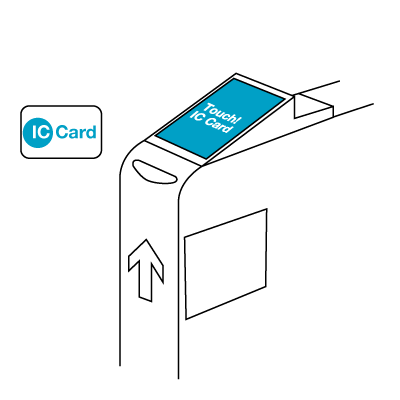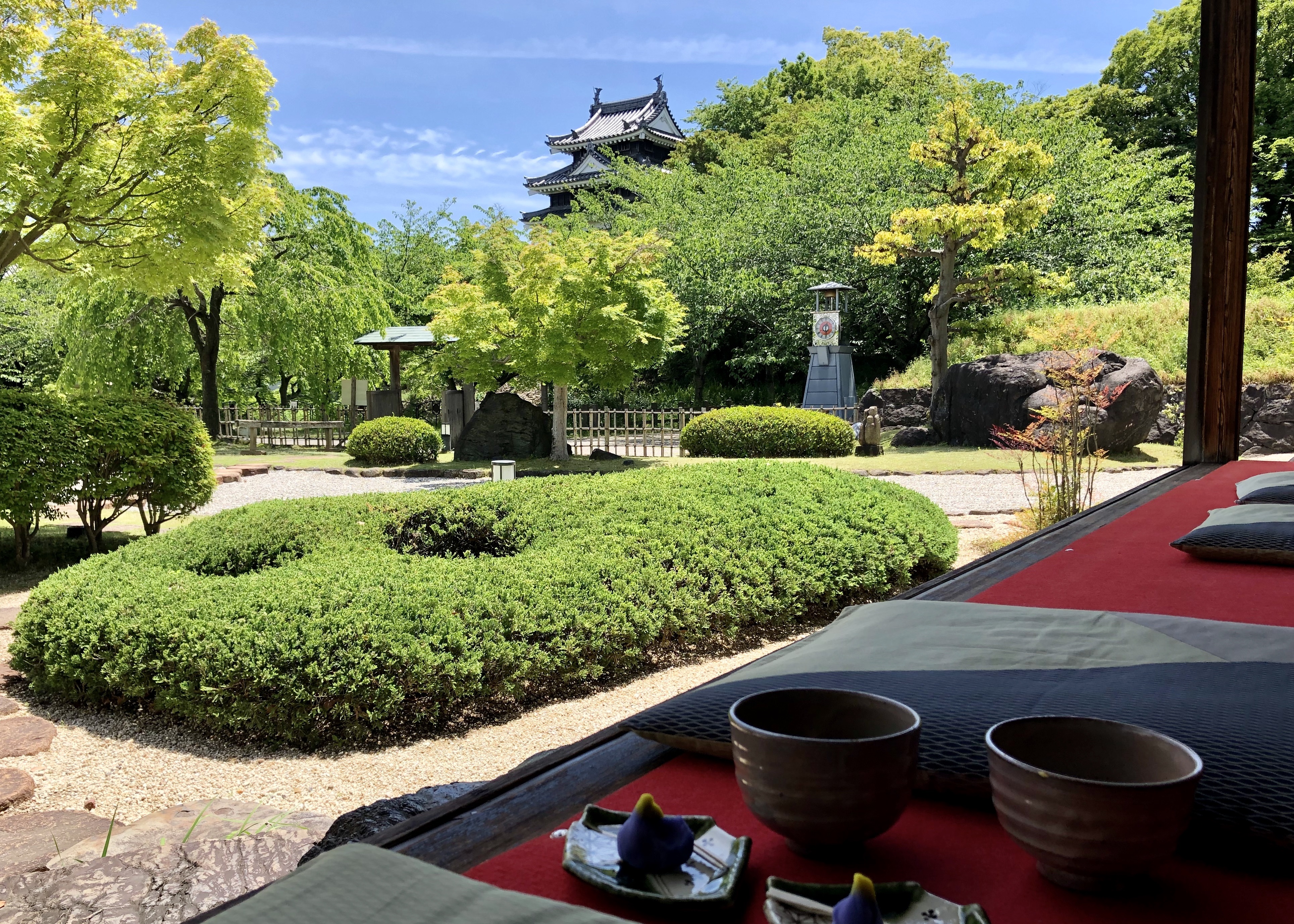|
Kira-Yoshida Station
is a railway station in the city of Nishio, Aichi, Japan, operated by Meitetsu. Lines Kira Yoshida Station is a served by the Meitetsu Nishio Line, and is located 24.7 kilometers from the starting point of the line at . It is also a terminus of the Meitetsu Gamagōri Line, and is located 17.6 kilometers from the starting point of the line at . Station layout The station has two pairs of opposed side platforms. Each pair is set at an angle to each other, forming a "V" shape. Platform one is not in use. The station has automated ticket machines, Manaca automated turnstiles and is attended. Platforms Adjacent stations Station history Kira Yoshida Station was opened on August 25, 1928, as on the Mikawa Railway. The station was renamed to its present name on November 1, 1960. Passenger statistics In fiscal 2017, the station was used by an average of 1452 passengers daily (boarding passengers only). Surrounding area *former Kira Town Hall *Yoshida Eleme ... [...More Info...] [...Related Items...] OR: [Wikipedia] [Google] [Baidu] |
Side Platform
A side platform (also known as a marginal platform or a single-face platform) is a platform positioned to the side of one or more railway tracks or guideways at a railway station, tram stop, or transitway. A station having dual side platforms, one for each direction of travel, is the basic design used for double-track railway lines (as opposed to, for instance, the island platform where a single platform lies between the tracks). Side platforms may result in a wider overall footprint for the station compared with an island platform where a single width of platform can be shared by riders using either track. In some stations, the two side platforms are connected by a footbridge running above and over the tracks. While a pair of side platforms is often provided on a dual-track line, a single side platform is usually sufficient for a single-track line. Layout Where the station is close to a level crossing (grade crossing) the platforms may either be on the same side of the cross ... [...More Info...] [...Related Items...] OR: [Wikipedia] [Google] [Baidu] |
Railway Stations In Aichi Prefecture
Rail transport (also known as train transport) is a means of transport that transfers passengers and goods on wheeled vehicles running on rails, which are incorporated in tracks. In contrast to road transport, where the vehicles run on a prepared flat surface, rail vehicles (rolling stock) are directionally guided by the tracks on which they run. Tracks usually consist of steel rails, installed on sleepers (ties) set in ballast, on which the rolling stock, usually fitted with metal wheels, moves. Other variations are also possible, such as "slab track", in which the rails are fastened to a concrete foundation resting on a prepared subsurface. Rolling stock in a rail transport system generally encounters lower frictional resistance than rubber-tyred road vehicles, so passenger and freight cars (carriages and wagons) can be coupled into longer trains. The operation is carried out by a railway company, providing transport between train stations or freight customer facilit ... [...More Info...] [...Related Items...] OR: [Wikipedia] [Google] [Baidu] |
Railway Stations In Japan Opened In 1928
Rail transport (also known as train transport) is a means of transport that transfers passengers and goods on wheeled vehicles running on rails, which are incorporated in tracks. In contrast to road transport, where the vehicles run on a prepared flat surface, rail vehicles (rolling stock) are directionally guided by the tracks on which they run. Tracks usually consist of steel rails, installed on sleepers (ties) set in ballast, on which the rolling stock, usually fitted with metal wheels, moves. Other variations are also possible, such as "slab track", in which the rails are fastened to a concrete foundation resting on a prepared subsurface. Rolling stock in a rail transport system generally encounters lower frictional resistance than rubber-tyred road vehicles, so passenger and freight cars (carriages and wagons) can be coupled into longer trains. The operation is carried out by a railway company, providing transport between train stations or freight customer faciliti ... [...More Info...] [...Related Items...] OR: [Wikipedia] [Google] [Baidu] |
List Of Railway Stations In Japan ...
The links below contain all of the 8579 railway stations in Japan. External links {{Portal bar, Japan, Trains * Railway stations Japan Japan ( ja, 日本, or , and formally , ''Nihonkoku'') is an island country in East Asia. It is situated in the northwest Pacific Ocean, and is bordered on the west by the Sea of Japan, while extending from the Sea of Okhotsk in the north ... [...More Info...] [...Related Items...] OR: [Wikipedia] [Google] [Baidu] |
Turnstile
A turnstile (also called a turnpike, gateline, baffle gate, automated gate, turn gate in some regions) is a form of gate which allows one person to pass at a time. A turnstile can be configured to enforce one-way human traffic. In addition, a turnstile can restrict passage only to people who insert a coin, ticket, pass, or other method of payment. Modern turnstiles incorporate biometrics, including retina scanning, fingerprints, and other individual human characteristics which can be scanned. Thus a turnstile can be used in the case of paid access (sometimes called a faregate or ticket barrier when used for this purpose), for example to access public transport, a pay toilet, or to restrict access to authorized people, for example in the lobby of an office building. History Turnstiles were originally used, like other forms of stile, to allow human beings to pass while keeping sheep or other livestock penned in. The use of turnstiles in most modern applications has been credit ... [...More Info...] [...Related Items...] OR: [Wikipedia] [Google] [Baidu] |
Manaca
Manaca, written in lower-case letters, is a rechargeable contactless smart card used in Nagoya, Japan and the surrounding area since February 11, 2011, when it replaced the Tranpass magnetic fare card system. As of March 23, 2013, it became compatible with 9 other IC cards, allowing it to be used nationwide. Etymology The name comes from the Japanese word , meaning "center", because Nagoya is roughly in the center of Japan, and because it claims to be a central part of your lifestyle. The name, even in Japanese, is written in Roman letters as "manaca", usually with a lowercase "m". Usage Manaca has a feature set similar to other prepaid IC Cards used across the country. It provides a convenient method of payment for train and bus fares while also being accepted as payment at some shops, restaurants, and vending machines. Manaca cards can be purchased from ticket machines located in subway, city bus and Meitetsu bus and train stations, and are available in both registered ... [...More Info...] [...Related Items...] OR: [Wikipedia] [Google] [Baidu] |
Ticket Machine
A ticket machine, also known as a ticket vending machine (TVM), is a vending machine that produces paper or electronic tickets, or recharges a stored-value card or smart card or the user's mobile wallet, typically on a smartphone. For instance, ticket machines dispense train tickets at railway stations, transit tickets at metro stations and tram tickets at some tram stops and in some trams. Token machines may dispense the ticket in the form of a token which has the same function as a paper or electronic ticket. The typical transaction consists of a user using the display interface to select the type and quantity of tickets and then choosing a payment method of either cash, credit/debit card or smartcard. The ticket(s) are then printed on paper and dispensed to the user, or loaded onto the user's smartcard or smartphone. Ticket and fare formats For most of the twentieth century, ticket machines issued paper tickets, or tokens worth one fare each. Later, fare value was loa ... [...More Info...] [...Related Items...] OR: [Wikipedia] [Google] [Baidu] |
Japan
Japan ( ja, 日本, or , and formally , ''Nihonkoku'') is an island country in East Asia. It is situated in the northwest Pacific Ocean, and is bordered on the west by the Sea of Japan, while extending from the Sea of Okhotsk in the north toward the East China Sea, Philippine Sea, and Taiwan in the south. Japan is a part of the Ring of Fire, and spans Japanese archipelago, an archipelago of List of islands of Japan, 6852 islands covering ; the five main islands are Hokkaido, Honshu (the "mainland"), Shikoku, Kyushu, and Okinawa Island, Okinawa. Tokyo is the Capital of Japan, nation's capital and largest city, followed by Yokohama, Osaka, Nagoya, Sapporo, Fukuoka, Kobe, and Kyoto. Japan is the List of countries and dependencies by population, eleventh most populous country in the world, as well as one of the List of countries and dependencies by population density, most densely populated and Urbanization by country, urbanized. About three-fourths of Geography of Japan, the c ... [...More Info...] [...Related Items...] OR: [Wikipedia] [Google] [Baidu] |
Meitetsu Logomark 2
, referred to as , is a private railway company operating around Aichi Prefecture and Gifu Prefecture of Japan. Some of the more famous trains operated by Meitetsu include the ''Panorama Car'' and the '' Panorama Car Super'', both of which offer views through their wide front windows. While the ''Panorama Super'' train is used extensively for the railroad's limited express service, the older and more energy-consuming ''Panorama Car'' train has been retired, the last run being on 27 December 2008. In the Tōkai region around Nagoya, it is a central firm of the Meitetsu Group, which is involved in the transportation industry, the retail trade, the service industry, and the real estate industry, etc. Meiji Mura is the corporate museum of Meitetsu. As of March 31, 2010, Meitetsu operated of track, 275 stations, and 1,090 train cars. Lines Major stations Major stations in Nagoya *NH36 : Meitetsu Nagoya Station *NH34 : Kanayama Station *NH33 : Jingū-mae Station *ST01 ... [...More Info...] [...Related Items...] OR: [Wikipedia] [Google] [Baidu] |
Nishio, Aichi
is a city located in Aichi Prefecture, in the Chūbu region of Japan. , the city had an estimated population of 169,984 in 65,553 households, with a population density of 1,054 persons per km². The total area of the city was . It is a regional commercial and manufacturing center and the country's leading producer of powdered green tea. Geography Nishio is situated on the northern coast of Mikawa Bay on the Pacific Ocean in southern Aichi Prefecture. The city lies along the eastern bank of the Yahagi River. Sheltered by Chita Peninsula and Atsumi Peninsula, the local climate is mild. Parts of the city lie within the borders of the Mikawa Wan Quasi-National Park Climate The city has a climate characterized by hot and humid summers, and relatively mild winters (Köppen climate classification ''Cfa''). The average annual temperature in Nishio is 15.7 °C. The average annual rainfall is 1596 mm with September as the wettest month. The temperatures are highest on average ... [...More Info...] [...Related Items...] OR: [Wikipedia] [Google] [Baidu] |
Train Station
A train station, railway station, railroad station or depot is a railway facility where trains stop to load or unload passengers, freight or both. It generally consists of at least one platform, one track and a station building providing such ancillary services as ticket sales, waiting rooms and baggage/freight service. If a station is on a single-track line, it often has a passing loop to facilitate traffic movements. Places at which passengers only occasionally board or leave a train, sometimes consisting of a short platform and a waiting shed but sometimes indicated by no more than a sign, are variously referred to as "stops", "flag stops", " halts", or "provisional stopping places". The stations themselves may be at ground level, underground or elevated. Connections may be available to intersecting rail lines or other transport modes such as buses, trams or other rapid transit systems. Terminology In British English, traditional terminology favours ''railway station' ... [...More Info...] [...Related Items...] OR: [Wikipedia] [Google] [Baidu] |






.jpg)